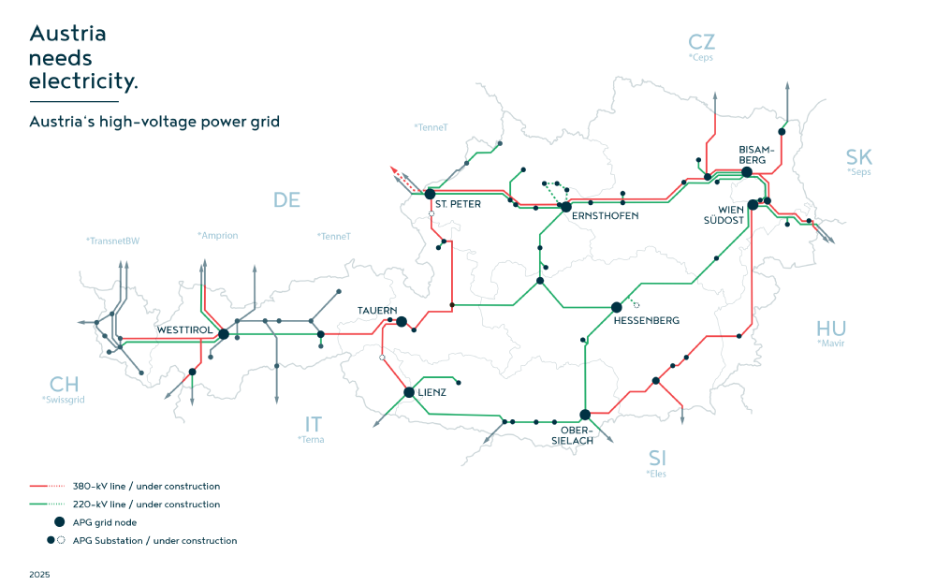Europe
On course for Europe
Europe is realising its vision of a single internal electricity market, and APG is helping to create the foundation for this. APG operates the cross-zonal electricity lines without which there could be no import or export of electricity. It also provides the marketplace that enables Austrian electricity traders and customers to access the European electricity market.
.png)
A strong power supply grid for a strong Europe
Since the end of the 1990s, the national electricity transmission grids across continental Europe have been converging to form a pan-European power grid. The European Network of Transmission System Operators for Electricity (ENTSO-E) includes five different synchronous areas (Nordic, Ireland, UK, Continental Europe, Baltic), 39 national transmission grids in 35 countries and provides more than 500 million people with a secure and reliable power supply.
Coordinating all of these international grids poses great challenges. The integrated European power grid also brings many advantages, however, including an enormous enhancement in energy security in Europe.
For example, if a major power plant or transmission line in the transmission system fails, the subsequent supply gap can be quickly filled in a cooperative effort, thus mitigating the risk of a variation in frequency, a drop in voltage (brownout) or even a total power outage (blackout). The greater the share of fluctuating supply in the grid (e.g. from wind farms), the more important it is to maintain a balanced grid and to safeguard grid operations via as many power plant units as possible.

The same rules for everyone
It’s only possible to run a transmission system when all of the participating grid operators follow the same rules. That is why grid operators in continental Europe previously agreed on common requirements and standards and signed a multilateral agreement (MLA) in which they undertook to comply with the Operation Handbook in which those requirements and standards were laid out. However, in order to extend the security rules uniformly to cover all key players in the power system (distribution system operators, power plant operators, major consumers) and all synchronous zones in Europe and to make rules more rigorously binding, the Operation Handbook was replaced a few years ago with EU legislation known as “network codes”. The remaining rules from the Operation Handbook for continental Europe were collated in April 2019 in the Synchronous Area Framework Agreement (SAFA) and also include the necessary agreements with non-EU countries which are part of ENTSO-E.
Cross-border cooperation between grid operators
In 1999, ETSO (European Transmission System Operators) was created as an association merging the four existing grid operator organisations in Europe (UCTE, NORDEL, ATSOI and UKTSOA) with the goal of better managing the new challenges arising from the open market.
In July 2009, all of the above organisations were integrated into ENTSO-E as the umbrella organisation. UCTE continues to exist as the Regional Group Continental Europe, and remains the contact entity when any cross-regional coordination issues arise. APG also maintains close relationships with neighbouring grid operators in Germany, Italy, Switzerland, Slovenia, Slovakia, Poland, the Czech Republic, Hungary and Croatia.

Transmission System Operator Security Cooperation
TSO Security Cooperation (TSC) was initially an association of eleven European transmission system operators. Its stated goal was to further increase the security of electricity transmission system in Central Europe and thus secure the supply of electricity for 170 million Europeans over the long term. Today TSCNET, which has a total of twelve members, is one of five Regional Security Coordinators (RSCs) – along with Coreso, SCC, Nordic RSC and Baltic RSC – that are now legally required under the network codes.
TSCNET
-
is one of the five RSCs in Europe which is tasked with improving the security of Europe’s power grid
-
enables the transmission system operators to coordinate their work more closely among each other
- provides essential services to participating transmission system operators:
- establishment of a Common Grid Model (CGM) (a collective, uniform method of calculating grid security)
- Coordinated Security Analysis (CSA)
- Coordinated Capacity Calculation (CCC)
- Outage Planning Coordination (OPC)
- Short and Medium Term Adequacy forecasts (SMTA)
- consistency check of the system defence and restoration plans (ER) of transmission system operators
- reporting on RSC coordination actions
-
develops and implements new multilateral processes and enhancements, which allows it to maintain high standards for plant security
-
helps transmission system operators to better manage their expanding operations, particularly with respect to the integration of wind power and the settlement of cross-zonal electricity trading and transmission operations, which are on the rise
Contact person

Kurt Misak

